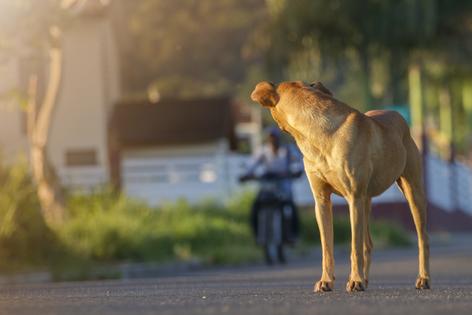My Pet World: Proximity training and desensitization can help dogs who chase 'bikes'
Dear Cathy,
I have an eight-year-old pit who despises motorcycles. When he was younger, he was fearful of them, but now he will lunge and attempt to chase them. He is quite strong, especially when on alert and could easily pull me to the ground. It has gotten to the point where I’m afraid to walk him in daylight for fear of encountering one. I know my anxiety plays a role in feeding into his behavior, but I honestly don’t know what to do. What can I do? — Paula, Levittown, New York
Dear Paula,
First, let’s make sure you aren’t pulled to the ground by your dog. Walk your dog on a head halter, not a harness. It attaches to your leash and gives you more control over your dog.
Second, some dogs need what’s called proximity and desensitization training to things with wheels, like motorcycles, cars, bicycles, strollers and even roller blades. To begin, expose him to a motorcycle that is turned off. Stand at a distance where you know he won’t bark and inch him toward the motorcycle giving him treats the entire time. If he lunges, step back far enough to where he stops. If you know the rider, you can ask them to walk their motorcycle around, always staying at the distance where your dog doesn’t react, and always giving him lots of praise and treats.
The next, more difficult task is to expose him to motorcycles on the roadway. This can be tricky, and it’s always easier to do if you have a friend with a motorcycle, but the same approach applies. Parking lots also are good places to encounter vehicles going at a slower pace, which might not rev up your dog so much.
This is a slow process, but with consistent exposure, he should get better at being around motorcycles. Dear Cathy,
My rescued cat, JulieT, is now about 13-years-old. She likes to lick credit card receipts, so I try to make certain there are none out for her to lick. Last fall, her vet diagnosed her with irritable bowel syndrome. I recently mentioned the IBS and the receipt-licking in a letter to my animal-loving niece, and she sent me information about the toxicity of receipts. I know JulieT has been having GI issues and thought maybe her fetishes could be the issue? I hope not. — Camille, Tucson, Arizona
Dear Camille,
There are several articles and reports online about the toxicity of receipts. According to a report from HealthyStuff.org, 93% of the receipts they tested had bisphenol A (BPA) or bisphenol S (BPS), a harmful chemical sometimes found in plastics. Over the last few years, several businesses have switched to phenol-free receipt paper, but not everyone has done so. (If you scratch the receipt and a line appears, it has BPA or BPS in it.)
I don’t know if this is the culprit with your cat’s IBS, but I would keep receipts away from JulieT and distract her with a catnip toy instead. You can opt for digital receipts if you want to avoid touching them or bringing them home entirely. Thanks for sharing. Dear Cathy,
I recently read your response to a reader asking about calming her dog during fireworks. I agree the Thundershirt works, but you have to help your dog realize this (wrap) is to help him or her feel safe. It’s important that it not be put on in a fearful moment, so the pet doesn’t associate the wearing of it with the loud noises about to happen. Otherwise, it can cause a stress reaction. Pets aren’t stupid after all! I’m sure you agree. — Margaret, Melbourne, Victoria, Australia
Dear Margaret,
You are right. If you only give a dog a peanut butter treat before or during a storm, a dog may associate the peanut butter with the storm and react as if there was actually a storm going on whenever he is given peanut butter, even if there is not. The same holds true with the Thundershirt. If you only put the wrap on your dog when there is a storm, then the dog will associate the wrap with storms.
When you first get a Thundershirt, dogs should initially wear it during pleasant events, like dog walking or receiving affection from you. Give the dog lots of treats when wearing it. As a dog becomes more adjusted to it, introduce it a few hours before an anxiety-producing event and leave it on for several hours afterward so it’s not connected to the event.
========
(Cathy M. Rosenthal is a longtime animal advocate, author, columnist and pet expert who has more than 25 years in the animal welfare field. Send your pet questions, stories and tips to cathy@petpundit.com. Please include your name, city, and state. You can follow her @cathymrosenthal.)
©2021 Tribune Content Agency, LLC.
(c) 2021 DISTRIBUTED BY TRIBUNE MEDIA SERVICES, INC.










